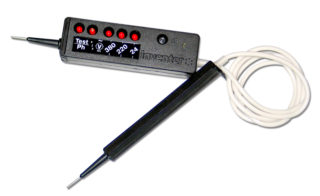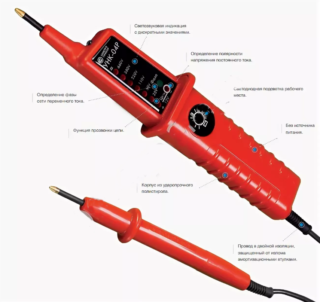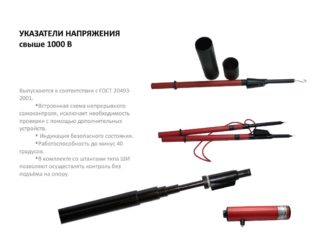Indicators, or voltage indicators, are portable electrical structures, the task of which is to check the presence or absence of voltage on the current-carrying sections of the circuit. Most often, such a check is required before equipping the room with a grounding system and before starting construction work.
Varieties of voltage indicators

Voltage indicators are divided into several types depending on design features and available functionality. Main classifications:
- By voltage power: indicator up to 1000V and over 1kV.
- By type of measurement current: devices designed for direct and alternating current.
- By the number of poles: one- and two-pole.
- By the type of indicator: digital and with the use of LED bulbs.
The non-contact voltage indicator is an innovative device that has become widespread due to its safe use in various, even unfavorable circumstances.
Device and principle of operation
Single pole devices

To calculate the presence of voltage, it is necessary to touch the working element to the current-carrying part. Grounding is provided to the human body when a finger touches the contact located on the pointer. The lamp starts to glow, because as a result of the above manipulations, a small current is generated, about 0.3 milliamperes.
Typically, a low voltage indicator is made in the form of an ordinary flat screwdriver or a fountain pen. The inner cavity of the case is equipped with a neon or LED lamp and a resistor. In the lower part of the structure there is a probe and a spring, and in the upper part there is a contact pad designed for touching with fingers.
Such a device is used for the purpose of checking alternating current, since with constant the lighting element will not glow even in the presence of voltage. It is preferable to use a single-pole indicator to monitor phase conductors, phases in a socket, socket, switch.
A single-pole indicator is allowed to be used up to 1000V without protective equipment, in particular, rubber gloves.
Of the design flaws, it is worth highlighting the low sensitivity. The presence of voltage is displayed only if its power is more than 90V.
Two-pole indicator structures

This design includes several separate parts, which are made of copper flexible insulated conductor and dielectric material. Both parts are interconnected.
To verify the presence or absence of voltage using this type of indicators, you need to touch the two elements of the device, between which the voltage must pass. If voltage is present, the neon or LED light will be lit by the current flowing through them.
The current is extremely small, only a few milliamps. However, this value is sufficient for the lamp to produce a stable light signal. A resistor is connected in series to the lamp to limit the current.
On the basis of this design, indicators are made for measuring voltage values.They are equipped with a special LED scale, which is graduated to specific voltage values.
Devices designed for voltages above 1 kV
Each model has its own design features, but they all consist of the same set of elements: a working part, which includes a capacitor, a signal lamp, a housing; insulating part; pointer handle.
For personal safety, use the high voltage indicator only with rubber gloves. Before using the device, it is required to inspect it for damage, make sure it is working properly and has a signal.
The control is carried out by bringing a probe to the live parts of the device, which is under voltage under any circumstances. You can make sure that it works with a megohmmeter or a high voltage source. The high voltage indicator can be checked in the garage as follows: the indicator is carefully brought closer to one of the spark plugs of the car, moped or motorcycle engine running.
For safe use, the device must not be grounded, as the grounding conductor may accidentally touch live parts and cause electric shock to a person. The high voltage gauge is capable of displaying data correctly even without a ground connection.
Universal devices

Such designs are used for the purpose of monitoring the phase and zero, as well as for checking the voltage and its value. The value for direct current reaches no more than 0.5 kV, and for alternating current it ranges from 12 to 750 volts. The devices are used to test connections in electrical communications.
The universal device can additionally be equipped with a digital display that shows approximate data. Despite the large number of advantageous features, the design has a low accuracy of readings. The main advantage is the lack of a power source.
Non-contact pointers are necessary for calculating live conductors under voltage. They do not have to be on the surface, they can be hidden in the walls or ceiling. The peculiarity of the device is its susceptibility to an electromagnetic alternating field. The models are equipped with light and sound indication.
Terms of use
Before using the device, it is important each time to inspect it for damage and insulation quality, and then make sure that the indicator is working. You need to touch the phase, knowing that it is energized. If the instrument is defective, an error will occur, causing injury or short circuit. When using the indicator, it is important to be careful and careful, strictly follow the following rules:
- The pointer must necessarily correspond to the parameters of the electrical network. It is quite simple to make sure of this, you just need to familiarize yourself with the marking located on the device case.
- One of the most effective and easy-to-implement ways to avoid unwanted contact is to keep your free hand in your pocket, otherwise there is a possibility of creating a closed circuit for an electrical discharge.
- During the performance check, you need to take a stable posture, excluding the possibility of falling or accidentally touching the grounded conductors.
To minimize the likelihood of accidents, you must strictly follow all the rules and requirements for the work, as well as use personal protective equipment. Do not use dielectric gloves when using single pole devices. Contact between the specialist's finger and the plate located on the indicator handle for grounding must be ensured. If difficulties arise when performing work, it is better to turn to experienced electricians who will reduce the time spent and save health. You can find a specialist in the RES, an energy supply company or a housing office, they will provide all the necessary information.









